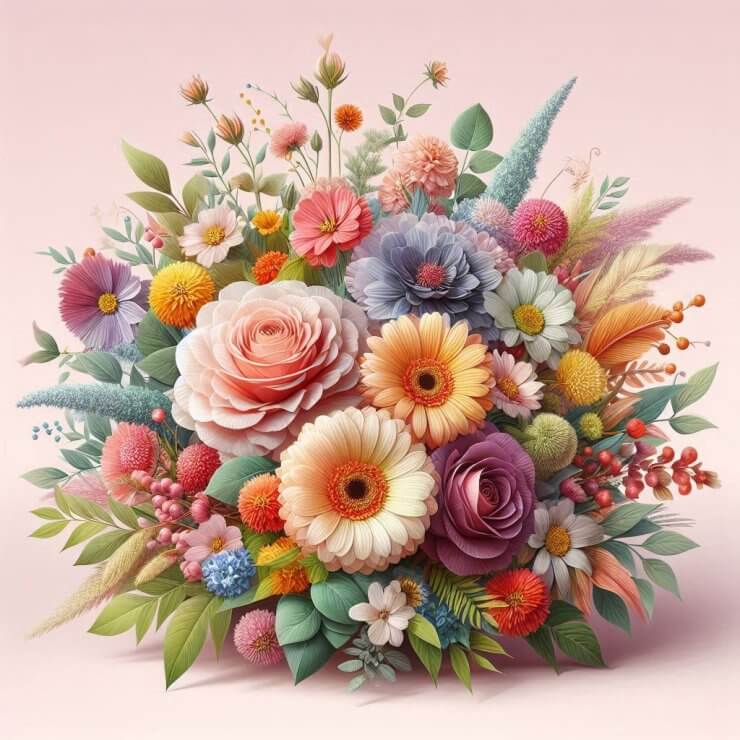Read by Matilda Longbottom

Every summer brings that familiar itch to identify every bloom I spot and mentally catalog them for next year’s garden expansion. Maybe you do the same? There’s something magical about having an endless supply of fresh flowers to share in your own cut flower garden—whether it’s surprising my daughter’s teachers with end-of and beginning-of school year bundles, bringing hostess gifts that actually grew in my backyard, or watching my little entrepreneur set up her roadside flower stand. What started as a few edible flower beds has evolved into dedicated cutting gardens that supply bouquets all summer long.
Here are twelve exceptional flowers that have earned permanent spots in my cut flower garden, each bringing something special to both the garden and the vase.
Ageratum
These little fluffy clouds of flowers come in blue, purple, pink, and white, and they’re perfect for filling in gaps in arrangements. They have this soft, almost fuzzy texture that plays really nicely with more structured flowers. Plus they just keep blooming from when you plant them until frost kills them, which is pretty great for lazy gardeners like me. They want full sun to partial shade and decent drainage, but they’re pretty forgiving overall. Just keep them watered during dry spells and they’ll be happy.
Campanulas (Bellflowers)
After seeing someone use pink bellflowers as elegant shot glasses at a party, I realized I needed to think bigger about how flowers can enhance our lives beyond simple arrangements. They have these perfect little bell shapes in purple, blue, pink, and white that just scream cottage garden vibes. In arrangements, they’re amazing filler flowers – they add this lovely movement and texture without being too busy. Plus their stems are actually sturdy, which is more than I can say for some flowers. They’re pretty easygoing about where you plant them, though they seem happiest with some afternoon shade and decent drainage. The best part? They self-seed like crazy, so you’ll have more every year without doing anything.
Dahlias
Okay, I’m slightly obsessed with dahlias. They come in basically every color you can think of – deep burgundy, bright coral, soft pastels, pure white, and everything in between. Some are tiny pompoms, others are massive dinner plate-sized monsters with the most intricate petal patterns. In bouquets, they’re total show-offs in the best way. They demand attention and somehow make everything else look better too. They want well-draining soil loaded with compost and all the sun you can give them. Just wait until after your last frost to plant the tubers, and definitely stake the tall ones unless you want them flopping over after the first decent rainstorm.
Delphinium
If you want drama in your arrangements, delphinium is your flower. These things are giants – towering spikes covered in blue, purple, pink, or white flowers that make everything else look tiny. I love using the whole spike for big arrangements, but you can also pop off individual flowers for smaller bouquets. Fair warning though – these are the divas of the flower world. They want cool weather, rich soil, consistent water, and definitely need staking or they’ll topple over. But when they’re happy, they’ll often give you a second round of blooms if you cut them back after the first show.
Safety note: All parts of delphinium are toxic to humans and pets, but they’re commonly used by florists in bouquets and arrangements. Always wear gloves when cutting and handling, keep away from children and animals, and wash hands thoroughly afterward. Never use as food decoration or garnish.
Feverfew
I love these cheerful little white daisies with their bright yellow centers – they’re like the ultimate cottage garden flower. They work perfectly as filler in arrangements, adding this light, airy feeling that keeps things from looking too heavy. The bonus is that the leaves smell amazing when you brush against them. This stuff basically grows itself once you get it established. It self-seeds everywhere (which you’ll either love or hate), tolerates pretty much any conditions, and blooms all summer long. Just give it some sun and decent drainage and it’s golden.
Lisianthus
These are probably the fanciest flowers on my list – they look like roses and peonies had a baby, with all these ruffled, layered petals in soft purples, pinks, whites, yellows, and blues. They’re absolutely gorgeous in arrangements and last forever in the vase, which makes them worth the extra effort. And trust me, they are extra effort. They’re picky about temperature, want cool roots but warm tops, need consistent water but perfect drainage. I treat them like the prima donnas they are, but when they bloom, I forgive them everything.
Peony
Peonies are pure luxury – massive, fragrant flowers that feel like silk and smell incredible. They come in shades of pink, white, coral, and deep red, and when they’re in bloom, they completely steal the show in any arrangement. The downside is their season is painfully short, but that almost makes them more precious. Plant them in fall with the eyes just barely under the soil surface, give them full sun and rich, well-draining soil, then be patient. They might sulk for a year or two, but once they’re established, you’ll get decades of stunning blooms.
Ranunculus
These flowers are like little works of art – all those papery, layered petals unfurling like tissue paper roses. They come in the most amazing colors too – vibrant oranges, yellows, pinks, reds, whites, and some with gorgeous color gradations. They’re perfect as focal points in smaller arrangements or fancy filler in bigger ones. The weird claw-like tubers need to be planted in fall in warm areas or started indoors for spring planting elsewhere. They’re a bit fussy about temperature – they like it cool, ideally under 70°F – but when conditions are right, they’re absolutely magical.
Safety note: Fresh ranunculus plants can cause skin irritation and are toxic if eaten, but they’re safe for cut flower arrangements with basic precautions. Wear gloves when handling plants and tubers, and keep away from children and pets. Once cut and arranged, they’re fine to handle normally.
Snapdragon
I love snapdragons because they’re just fun – those dragon-mouth flowers that you can actually squeeze to make “snap” open. They come in pretty much every color except blue, and the tall spikes add great structure to arrangements. These are cool-season flowers, so in mild climates you can grow them through winter, while in colder areas you plant them in early spring. They want full sun to partial shade and good drainage. Pro tip: pinch the first flowers to encourage more side shoots and bushier plants.
Strawflower
These papery flowers are exactly what they sound like – they feel like straw and last basically forever, both fresh and dried. They come in bright yellows, oranges, pinks, reds, and whites, and they’re perfect for arrangements that need to last or for drying for winter crafts. They’re heat lovers that want full sun and well-draining soil, and they actually prefer things a bit on the dry side once they’re established. Start them from seed either indoors or direct sow after your last frost.
Yarrow
Yarrow gives you these flat-topped clusters of tiny flowers in yellow, white, pink, red, or purple that work beautifully as textural filler in arrangements. They also dry really well if you want to extend their usefulness into fall crafts. This stuff is practically indestructible – it thrives in poor soil, loves full sun, and actually performs better when you don’t baby it with rich soil or too much water. Perfect for those hot, dry spots in your garden where nothing else wants to grow.
Zinnia
Zinnias are pure happiness in flower form – bright, cheerful blooms in pink, red, orange, yellow, purple, and white that just make you smile. They come in all different forms too, from simple daisies to full pompoms. They’re incredibly reliable cut flowers and attract tons of butterflies and beneficial bugs to your garden. These are heat-loving annuals that want full sun and decent drainage, but they’re so easy to grow from seed and bloom nonstop until frost. Perfect for beginners or anyone who wants guaranteed success.

Don’t forget the greens!
While flowers are obviously the stars of any bouquet, the right foliage and textural elements can make or break an arrangement. I’ve learned that having a good variety of greens and herbs in the cutting garden is just as important as the blooms themselves.
- Eucalyptus is probably my most-used foliage – those silvery-blue leaves add instant sophistication to any arrangement and smell incredible. It’s drought-tolerant once established and thrives in full sun with good drainage. The baby blue variety is especially gorgeous.
- Dusty Miller gives you that soft, velvety silver texture that plays beautifully with almost any flower color. It’s technically an annual but often overwinters in mild climates. It wants full sun and well-draining soil, and honestly, it’s almost impossible to kill.
- Rosemary isn’t just for cooking – those needle-like leaves and woody stems add amazing texture to arrangements, plus the fragrance is divine. It’s a perennial herb that loves full sun and dry conditions. Just pinch it regularly to keep it bushy.
- Mint varieties like chocolate mint or apple mint give you those perfect rounded leaves and fresh scent. They’re ridiculously easy to grow (maybe too easy – contain them or they’ll take over), prefer partial shade, and add a lovely casual element to bouquets.
- Lamb’s Ear has the softest, fuzziest silver leaves that are perfect for adding a whimsical cottage garden feel. It’s a perennial that tolerates poor soil and drought once established, though it prefers well-draining spots.
Building a dedicated cutting garden transforms the simple pleasure of growing flowers into an endless source of joy, creativity, and connection with others. Whether you’re starting with a single raised bed or converting an entire backyard, these twelve reliable performers will keep your vases full and your heart happy all season long. ❖
What types of flowers do you like to grow for bouquets? Let me know what I should add!


 Previous
Previous



Very informative – I learned so much about some flowers I have not been familiar with. Excellent article.